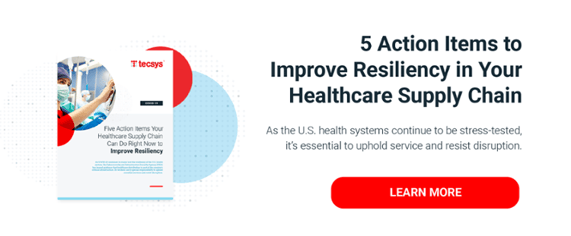How Healthcare Is Managing Unpredictability
Health systems are flexing their emergency preparedness muscles like never before. The unpredictability and power of COVID-19 is slowly unveiling which hospitals are prepared to manage a major epidemic. Although every health system conducts emergency preparedness training year-round, each organization builds a unique culture and strategy that works best for their organization.
At Tecsys, we’ve been in constant communication with our healthcare customers to support their supply chain operations. We are proud how this community is tackling the challenges they are being faced with on a daily basis. The innovation, transformation and resiliency are truly remarkable and I wanted to share a few strategies we’re seeing our customers deploy.
1. Increasing Warehouse Capacity
In reaction to supporting their facilities and communities, several health systems are increasing their warehouse capacity to handle a greater volume of orders of supplies and to centralize the stockpiling of ventilators and their distribution across their network. Some health systems are also looking to stand up emergency warehouses to better respond to clinical staff needs and react quickly to urgent requests. Both strategies require supply chain professionals to tackle a large project in a very short amount of time.
My colleague, Mark Dubois, wrote about “4 Ways Optimizing Warehouse Picking Can Help Save Time & Money” that would be beneficial to read if you are examining your warehouse operations.
2. Automating Supply Replenishment and Opening New Storage Rooms
Several hospitals are opening temporary Intensive Care Units (ICU), which require new supply rooms to be set up to manage the medical supplies required for these critical units. Also, many health systems are accelerating the reorganization of existing supply rooms on nursing floor units to effectively manage supplies and improve service for clinical staff. Automation technology at the point of use is helping to significantly reduce supply chain staff movement in patient care areas, yet enabling materials managers to still determine what products have been consumed and need to be replenished. The ability to decrease unnecessary disruptions to clinical workflows is extremely important during this time when clinicians are overwhelmed with patient care.
If you are being tasked to design/redesign a storeroom for your facility, my colleague, Carlo Malaguti, shared “Budget-friendly Tech Tools for Your Healthcare Storeroom” that might be helpful to you right now. Additionally, to see a great example of how to streamline activities and increase the accuracy of supply replenishment, watch this Concord Hospital case study.
3. Monitoring Supplies Demand
Currently, it is crucial to monitor inventory movement and consumption to better balance the overall flow of materials, minimize demand fluctuation and most importantly prevent shortages. Health systems are putting in place mechanisms and controls to monitor usage of personal protective equipment (PPE) such as gloves, masks and visors. As an example, some organizations utilize tracking dashboards to control the supply and usage of these products and categorize PPE by level of importance to improve situational awareness and decision making. The dashboard is used to monitor and forecast the available days of inventory to ensure new resources are replenished on time.
Every healthcare provider is certainly going to take a closer look at its demand planning process once things begin to return to normal. Before you begin, I recommend reading this short piece of advice from my colleague, Nancy Pakieser, who was recently recognized as a 2020 Pros to Know.
In conclusion, the entire Tecsys team thanks everyone working in healthcare around the world. You are our heroes.




